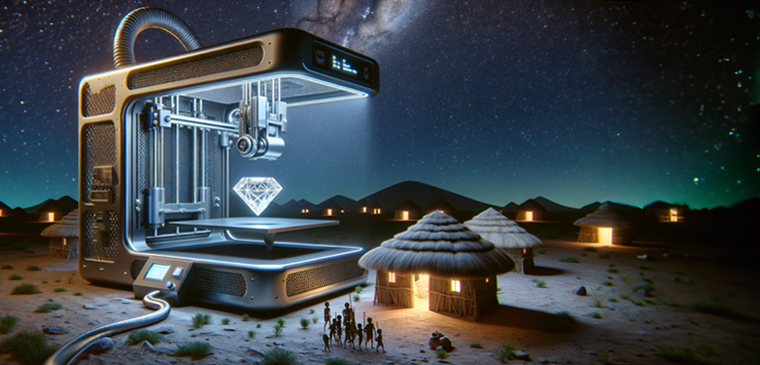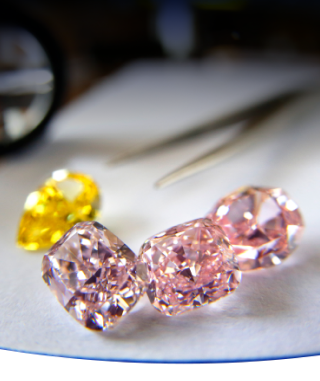The marketing strategy of lab-grown diamond companies, which emphasizes their products’ eco-friendliness, skillfully taps into the current environmental hype. However, this focus shifts attention away from a crucial fact: lab-grown diamonds are produced in energy-intensive large-scale printers. These printers were initially developed for creating superconductors from a material that imitates a diamond crystal. This shift in the conversation, from the inherent symbolism of natural diamonds to an emphasis on eco-friendliness, highlights the only narrative a printed diamond can offer jewelry consumers. Unfortunately, even this part of the narrative is not true.
When considering the purchase of a printed diamond, it’s important to remember these 5 points:
#1 Historical Significance and Symbolism:
Natural diamonds have long been symbols of success, status, and achievement, their allure stemming from the challenges of sourcing them from remote, untouched landscapes. Up until the early 20th century, people were willing to risk their lives for these precious stones, which were highly coveted by royalty and celebrities. Over time, they also came to symbolize enduring love and commitment.
In contrast, printed diamonds rely on our memories and emotional connection to natural diamonds to establish their value. Without this association, they are devoid of the rich history and emotional value that give natural diamonds their prestige and legacy.
#2 The Sales Pitch Reveals Your Profile:
The typical sales pitch for a printed diamond often starts with “It looks exactly the same,” followed by “Who’s going to know?” This strategy is strikingly similar to the tactics used in selling counterfeit luxury items like fake branded watches and bags. It undermines the authenticity and exclusivity essential to genuine luxury. Crucially, many buyers of printed diamonds prefer not to be asked about their diamond’s origin, hoping others will assume it’s a natural diamond.
This expectation reflects the underlying strategy of sellers, who count on consumers’ desire to possess what appears to be a luxurious, original natural diamond without the associated cost.
#3 Value Perception and Legacy:
Natural diamonds often passed down as wealth-preserving heirlooms, embody a lasting value distinctly different from that of lab-grown diamonds. With the manufacturing cost of a lab-grown diamond now as low as $12 per carat, they are increasingly perceived as disposable fashion items. This contrasts sharply with the enduring luxury of natural diamonds, which often command high prices on the pre-owned market. Furthermore, the likelihood of diamond mining coming to a halt in the next few decades suggests a significant potential increase in the value of natural diamonds.

#4 The Energy Myth
According to researchers from HSE University, RAS, and Skoltech, a comparison of energy consumption between traditional diamond mining and lab-grown diamond synthesis reveals that producing a one-carat lab-grown diamond requires, on average, 200 kWh of electricity, enough to power a small African village for a week. This significant energy requirement challenges the perception of lab-grown diamonds as eco-friendly.
In contrast, extracting a one-carat natural diamond typically uses about three-quarters of this amount, revealing the deliberate disinformation distributed by lab-grown diamond producers to assert some kind of advantage over natural diamonds.
#5 Price of A Meal or a Diamond?
Currently, printed diamonds are retailed in jewelry stores with an approximate markup of 400%. However, as is common in many industries, manufacturers are likely to eventually establish direct channels to reach end consumers. When this shift occurs, the market dynamics for these diamonds will experience a drastic transformation. It’s conceivable that they could then be sold for the cost equivalent to a meal at a high-end restaurant, or even be distributed as promotional giveaways.
Such a shift would reveal their true market value, devoid of the retail markup. This potential evolution in the market highlights the ephemeral nature of the appeal and value of printed diamonds.
Some numbers
A research comparing the energy consumption between lab-grown and natural diamonds was conducted by researchers from HSE University, the Institute of Oil and Gas Problems of the Siberian Branch of the Russian Academy of Sciences, and Skoltech. Their study analyzed the specific energy consumption data for diamond production based on reports from leading diamond producers like Alrosa and De Beers, as well as data from laboratory studies of synthesis processes. This is what they found:
- Natural Diamond Production: Average energy consumption is between 96 and 150 kWh per carat.
- Lab-Grown Diamond Production (CVD method): Average energy consumption can exceed 200 kWh per carat.
Let’s compute this ratio.
The ratio of energy consumption between natural diamond production and lab-grown diamond production using the Chemical Vapor Deposition (CVD) method is approximately 0.75. This indicates that, on average, producing a one-carat natural diamond consumes about 75% of the energy required to produce a one-carat lab-grown diamond using the CVD method.








